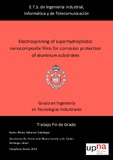Electrospinnig of superhydrophobic nanocomposite films for corrosion protection of aluminum substrates
Fecha
2019Versión
Acceso abierto / Sarbide irekia
Tipo
Trabajo Fin de Grado/Gradu Amaierako Lana
Impacto
|
|
nodoi-noplumx
|
Resumen
In this work, the electrospinning technique is used for the synthesis of
micro/nanofibers using a polymeric precursor with hydrophobic (even
superhydrophobic) behaviour such as polystyrene (PS) or polyvinyl chloride
(PVC). These electrospun fibers are deposited onto aluminum substrates
(6061T6). The effect of ...
[++]
In this work, the electrospinning technique is used for the synthesis of
micro/nanofibers using a polymeric precursor with hydrophobic (even
superhydrophobic) behaviour such as polystyrene (PS) or polyvinyl chloride
(PVC). These electrospun fibers are deposited onto aluminum substrates
(6061T6). The effect of varying the different electrospinning deposition
parameters (mostly applied voltage and flow-rate) will be exhaustively analyzed
in order to optimize the resultant electrospun coatings. Several fiber
characterization tests have been performed, including Field Emission Scanning
Electron Microscopy (FE-SEM), Atomic Force Microscopy (AFM),
Thermogravimetric analysis (TGA),
Differential Scanning Calorimetry (DSC),
Optical Microscopy (OM) and Water
Contact Angle (WCA) measurements.
Furthermore, the anti-corrosion properties
of these electrospun coatings can be
enhanced by the addition of metal oxide
nanoparticles (ZnO) that act as corrosion
inhibitors. Finally, electrochemical corrosion tests (Tafel and pitting tests) have
been performed, showing an improvement in
the resultant corrosion resistance of
the aluminum alloys coated by the combination of both polymeric films with
metal oxide inorganic nanoparticles. [--]
Materias
Electrospinning,
Superhydrophobic,
Corrosion,
Micro/nanofibers,
Polyvinyl chloride (PVC),
Polystyrene (PS),
Metal oxide nanoparticles
Titulación
Graduado o Graduada en Ingeniería en Tecnologías Industriales por la Universidad Pública de Navarra /
Industria Teknologietako Ingeniaritzan Graduatua Nafarroako Unibertsitate Publikoan



